Method for production of a component by atomic diffusion bonding
- Summary
- Abstract
- Description
- Claims
- Application Information
AI Technical Summary
Benefits of technology
Problems solved by technology
Method used
Image
Examples
Embodiment Construction
[0069]Preferred features of embodiments of the method according to the invention and the component produced with the method are described below substantially with reference to the preparation of plates, the production of the component by atomic diffusion bonding, and the processing of the metal layer in the atomic diffusion bond. Details of the processing of the metal layer may be implemented as described in [3]. Accordingly, with respect to the features of the processing of the metal layer, [3] is introduced into the present disclosure by reference. Details of the complete structure and application of the component produced according to the invention, for example as an electrostatic holding device, are not described insofar as these are known from the prior art.
[0070]According to FIG. 1, before production of the component by atomic diffusion bonding, firstly a preparation step S1 takes place in which the plates are provided with the prepared bonding faces. In detail, the preparatio...
PUM
| Property | Measurement | Unit |
|---|---|---|
| Electric field strength | aaaaa | aaaaa |
| Surface roughness | aaaaa | aaaaa |
| Temperature | aaaaa | aaaaa |
Abstract
Description
Claims
Application Information
 Login to View More
Login to View More - R&D
- Intellectual Property
- Life Sciences
- Materials
- Tech Scout
- Unparalleled Data Quality
- Higher Quality Content
- 60% Fewer Hallucinations
Browse by: Latest US Patents, China's latest patents, Technical Efficacy Thesaurus, Application Domain, Technology Topic, Popular Technical Reports.
© 2025 PatSnap. All rights reserved.Legal|Privacy policy|Modern Slavery Act Transparency Statement|Sitemap|About US| Contact US: help@patsnap.com



